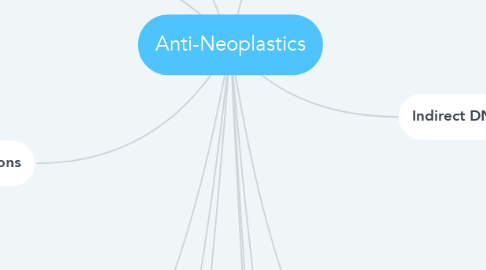
1. Microtubule Inhibitors
1.1. Vinca Alkaloids
1.1.1. Vinblastine
1.1.2. Vincristine
1.1.3. Vinorelbine (semi-synthetic)
2. Microtubule Promoters
2.1. Taxanes
2.1.1. Paclitaxel
2.1.2. Docetaxel
3. TOPO Poisons
3.1. Topo I Poisons
3.1.1. Epipodophyllotoxins
3.1.1.1. Etoposide
3.1.1.2. Teniposide
3.2. Topo II Poisons
3.2.1. Camptothecins
3.2.1.1. Topotecan
3.2.1.2. Irinotecan (PGx-UGTA1)
3.2.2. Anthracyclines
3.2.2.1. Doxorubicin
3.2.2.2. Danorubicin
3.2.2.3. Idarubicin
3.2.2.4. Epirubicin
4. Differentiating Agents
4.1. Tretinoin
4.1.1. increase differentiation of immature RBCs to functional ones
4.2. Arsenic trioxide
4.2.1. increase differentiation of immature RBCs to functional ones
5. RTK Inhibitors
5.1. Block GF Binding
5.1.1. Cetuximab
5.1.1.1. Works against EGFR
5.2. Inhibit RTK signaling
5.2.1. EGFR targets
5.2.1.1. Gefitinib (PGx)
5.2.1.2. Erlotinib (PGx)
5.2.2. BCR-ABL targets
5.2.2.1. Imatinib
5.2.2.2. Ponatinib
5.2.3. VEGF Inhibitors
5.2.3.1. Aflibercept
5.2.4. GPCR Inhibitors
5.2.4.1. Sonidegib (SMO - Hedgehog)
5.2.5. MAPK Inhibitors
5.2.5.1. Dabrafenib (BRAF)
5.2.5.2. Trametinib (MEK)
6. Anti-Estrogens
6.1. SERM
6.1.1. Tamoxifen
6.1.2. Toremifene
6.2. SERD
6.2.1. Fulvestrant
6.3. Aromatase Inhibitors
6.3.1. Type I
6.3.1.1. Exemestant
6.3.2. Type II
6.3.2.1. Anastrozole
6.3.2.2. Letrozole
7. Direct DNA Disruptors
7.1. Alkylating Agents
7.1.1. Cyclophosphamide (cross-linking)
7.1.2. Procarbazine (06-methylation)
7.2. Platinum Analogs
7.2.1. Cisplatin (intrastrand cross-linking)
7.3. DNA Strand Breakers
7.3.1. Mitoxantrone
7.3.2. Mitomycin C
7.4. DNA Cross-linking
7.4.1. Bleomycin
8. Indirect DNA Disruptors
8.1. Folate Analogs
8.1.1. Methotrexate (DHFR inhibition)
8.1.2. Pemetrexed (thymidylate synthase)
8.2. Pyrimidine Analogs
8.2.1. Fluoropyrimidines (thymidylate synthase & dTMP)
8.2.1.1. 5-FU (PGx-DPD)
8.2.1.2. Capecitabine (PGx-DPD)
8.2.2. Deoxycytidine (inhibit DNA elongation)
8.2.2.1. Cytarabine
8.2.2.2. Gemcitabine
8.3. Purine Analogs
8.3.1. Thipurines (inhibit nucleotide synthesis)
8.3.1.1. Mercaptopurine (PGx-TPMT)
8.3.1.2. Thioguanine (PGx-TPMT)
8.3.2. Adenosine Analogs (inhibit DNA elongation)
8.3.2.1. Fludrabine
8.3.2.2. Cladribine
8.3.2.3. Clofarabine
9. Miscellaneous DNA Disruptors
9.1. Asparaginase
9.1.1. hydrolyzes L-asparagine to acetic acid and ammonia to decrease asparagine levels in dependent cells
9.2. Pentostatin
9.2.1. inhibits adenosine deaminase to decrease DNA synthesis
9.3. Hydroxyurea
9.3.1. directly inhibits ribonucletoide reductase to decrease DNA synthesis
10. Miscellaneous Agents
10.1. Proteasome Inhibitors
10.1.1. Bortezomib
10.2. Biologic Response Modifiers
10.2.1. IF-a
10.2.1.1. increase T-cell response
10.2.2. IL-2
10.2.2.1. increase T-cell response
10.3. mAb Biologic Response Modifiers
10.3.1. Rituximab
10.3.1.1. 1. Promote immune response
10.3.1.2. 2. Prevent immune system downregulation
10.4. CTLA4 Inhibitors
10.4.1. Ipilimumab
10.4.1.1. 1. Increase T-cell activation
10.4.1.2. 2. Decrease checkpoint bypassing
10.5. PD-1 Inhibitors
10.5.1. Novilumab
10.5.1.1. 1. Increase T-cell activation
10.5.1.2. 2. Decrease checkpoint bypassing
10.6. PARP Inhibitors
10.6.1. Oliparib
10.6.1.1. Inhibits ss DNA break repair
10.7. CDK Inhibitors
10.7.1. Palbociclib
10.7.1.1. Inhibits cell cycle progression
10.8. HDAC Inhibitors
10.8.1. Panobinostat
10.8.1.1. Inhibits histone modifications
10.9. BCL-2 Inhibitors
10.9.1. Venetoclax
10.9.1.1. Induces apoptosis
11. Steroids
11.1. Dexemethasone
11.1.1. Cytotoxic
11.2. Prednisone
11.2.1. Cytotoxic
11.3. Medroxyprogesterone
11.3.1. Stimulate appetite
11.4. Megestrol aceteate
11.4.1. Stimulate appetite
12. Anti-Androgens
12.1. GnRH agonist
12.1.1. Leuprolid
12.2. GnRH antagonist
12.2.1. Degarelix
12.3. Androgen Receptor Inhibitor
12.3.1. Enzalutamide
12.4. Androgen Synthesis Inhibitor
12.4.1. Abiraterone

